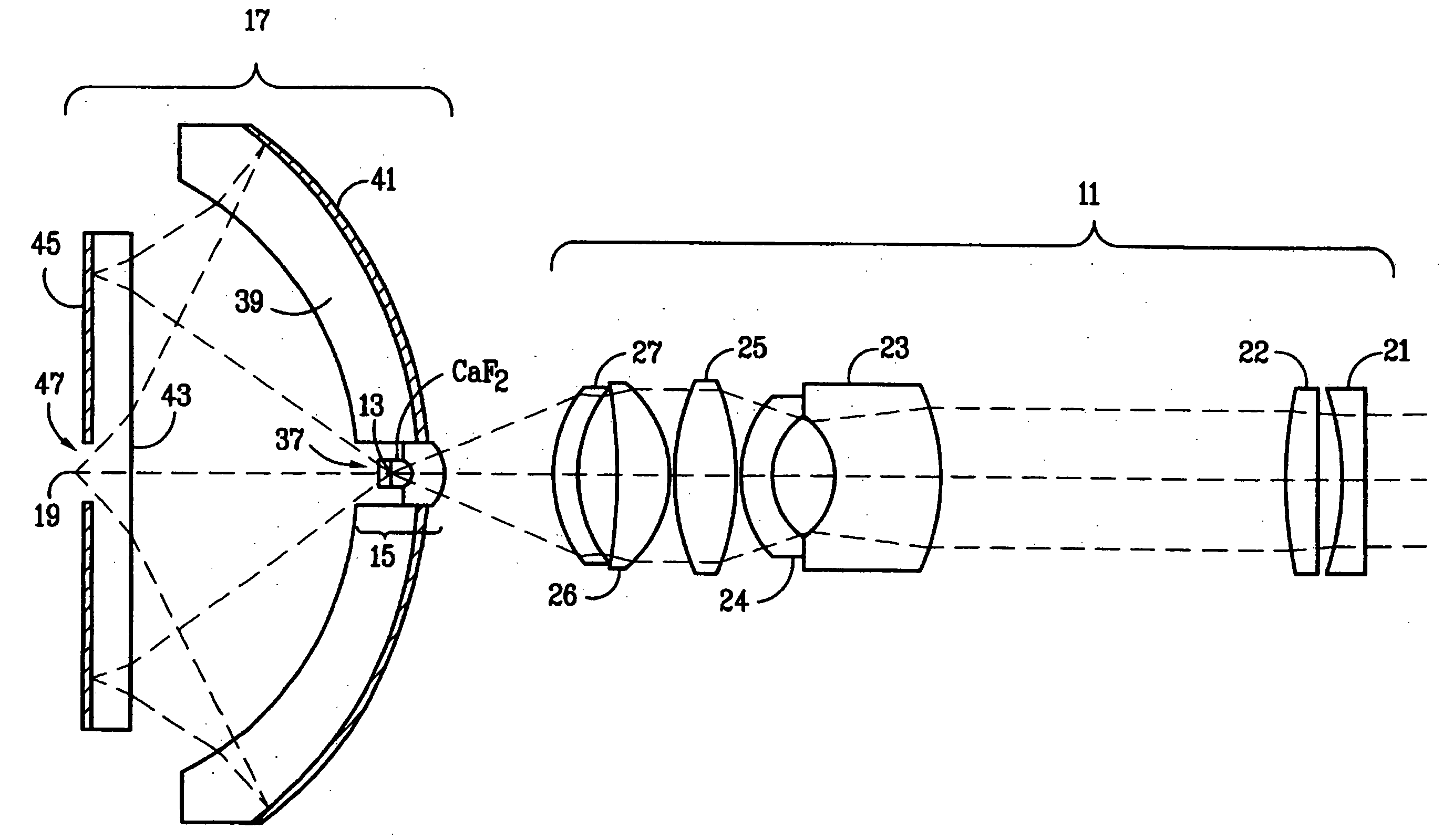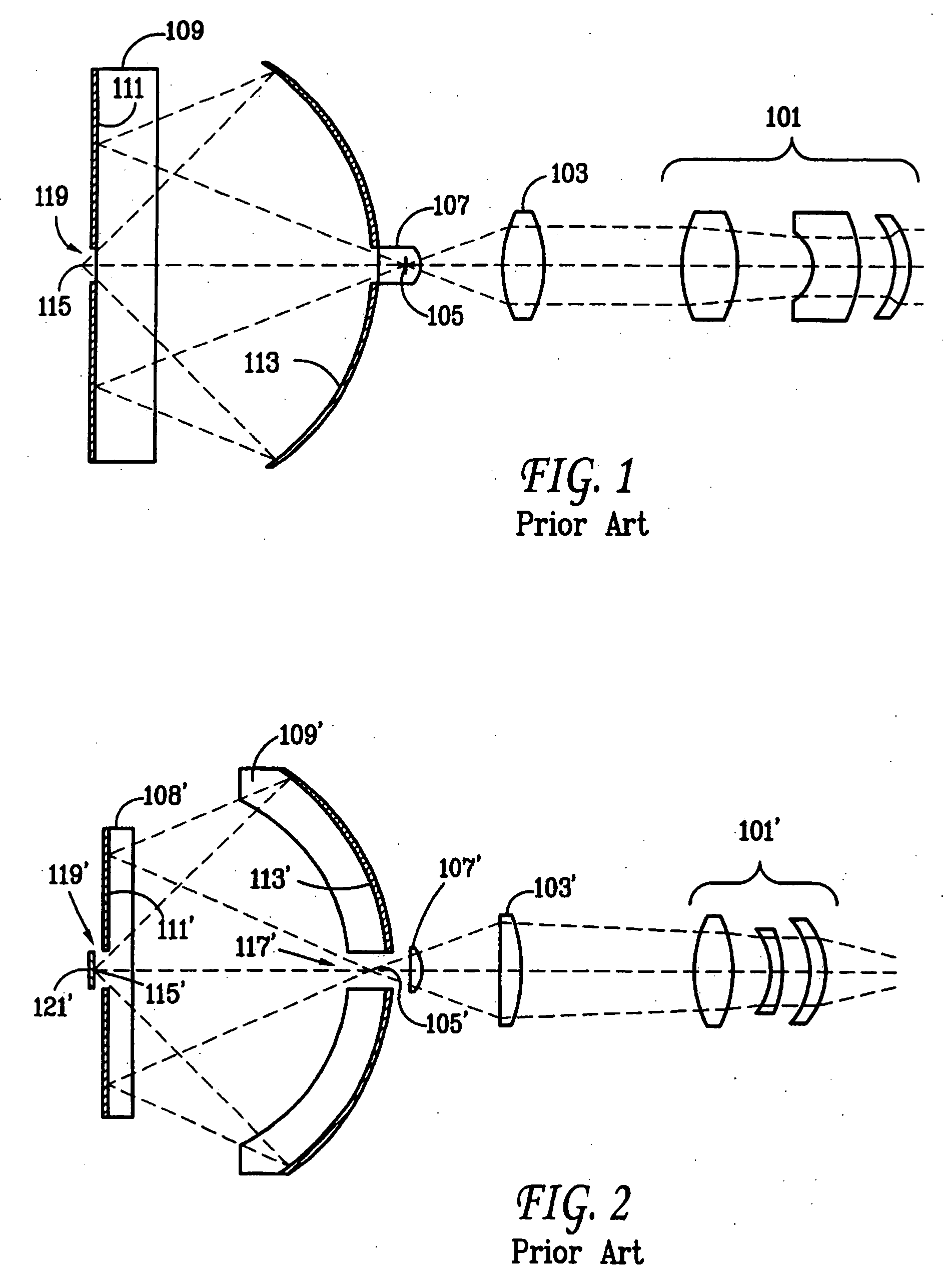Ultra-broadband UV microscope imaging system with wide range zoom capability
a microscope imaging and wide-range zoom technology, applied in the field of ultra-broadband ultraviolet (uv) catadioptric imaging microscope systems, can solve the problems of limiting aberration in these systems, unable to provide complete correction of residual (secondary and higher order) lateral color over a broad uv spectrum, and limiting aberration in the system, so as to achieve high numerical aperture and high performance.
- Summary
- Abstract
- Description
- Claims
- Application Information
AI Technical Summary
Benefits of technology
Problems solved by technology
Method used
Image
Examples
first embodiment
[0044] zoom lenses provides linear zoom motion with a fixed detector array position. FIG. 5 shows the 36.times. zoom arrangement of the lenses, the 64.times. zoom arrangement of the lenses and the 100.times. zoom arrangement of the lenses. The detector array 140 (not shown) is fixed. The zooming tube lens design. 141 is comprised of two moving lens groups 142 and 143. The beam splitter is not shown in this and later figures for the purpose of clarity. The following table lists the surfaces shown in FIG. 5, where the surface numbering begins at “0” for the final image counting towards the object being inspected.
[0045] Lens Data for the First Embodiment 0.90 N.A., fixed detector, 36.times.-100.times. zoom, 1.0 mm field size
SurfaceRadiusThicknessGlass0—30.000000 36XAir152.396279 64X318.839746100X1−46.8434424.000000Calciumfluoride267.0173790.999804Air3122.0034947.000000Silica4−34.9441444.496612Air5−42.8838894.000000Calciumfluoride6−1.5857e+03339.659737 36XAir298.114540 64X279.99739210...
second embodiment
[0046] zoom lenses provides linear zoom motion with a moving detector array position and FIG. 6 shows the 36.times. zoom arrangement of the lenses, the 64.times. zoom arrangement of the lenses and the 100.times. zoom arrangement of the lenses. The following table lists the surfaces shown in FIG. 6, where the surface numbering begins at “0” for the final image incrementing by 1 towards the object being inspected.
[0047] Lens Data for the Second Embodiment 0.90 N.A., moving detector, 36.times. to 100.times. zoom, 1.0 mm field size
SURFACERADIUSTHICKNESSGLASS0Infinity110.004950 36XAir405.371660 64X785.131189100X173.1566215.000000Calciumfluoride2−609.63843718.230155Air3−30.3030903.500000Calciumfluoride444.3616564.000000Air5−51.3189997.765282Silica6−23.2311951.564401Air7−119.7563154.000000Calciumfluoride840.00270112.019418Air954.59478910.000000Calciumfluoride10−28.9237440.100000Air11−29.9574115.000000Silica12−156.281481202.434836 36XAir108.230318 64X64.650627100X13188.6647704.500000Silic...
PUM
| Property | Measurement | Unit |
|---|---|---|
| wavelength | aaaaa | aaaaa |
| thickness | aaaaa | aaaaa |
| wavelength | aaaaa | aaaaa |
Abstract
Description
Claims
Application Information
 Login to View More
Login to View More - R&D
- Intellectual Property
- Life Sciences
- Materials
- Tech Scout
- Unparalleled Data Quality
- Higher Quality Content
- 60% Fewer Hallucinations
Browse by: Latest US Patents, China's latest patents, Technical Efficacy Thesaurus, Application Domain, Technology Topic, Popular Technical Reports.
© 2025 PatSnap. All rights reserved.Legal|Privacy policy|Modern Slavery Act Transparency Statement|Sitemap|About US| Contact US: help@patsnap.com



